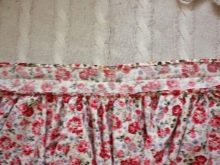How to sew skirts sun and half sun with folds, what to wear with them?

The skirt-sun and half-sun with pleats comes from Scotland. It was there that kilts first appeared - loose-fitting skirts with pleats. True, they were not intended for women, but were part of men's clothing. However, fashion does not stand still and soon wide pleated skirts firmly took their place in the wardrobe of beautiful ladies.

Skirts of the same cut can be radically different from each other in appearance, due to the huge number of types of folds.
They may be:
- one-sided and counter;
- wide and narrow;
- straight, fan, bow, asymmetrical;
- can be located along the entire height of the skirt or be stitched a few centimeters;
- bow folds are made in a chaotic manner and directed in different directions.


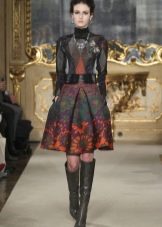

Who is it suitable for?
Skirts-sun and half-sun pleated fit all women, without exception. A fluffy, short skirt looks charming on a young fashionista.
A business lady will surely appreciate a mid-length model with elegant stitching pleats.
These skirts are versatile and suitable for any style of clothing - from classic to sporty.



Choosing the right model is necessary taking into account the characteristics of the physique:
- women with a "rectangle" or "inverted triangle" figure should pay attention to models with small folds. They visually enlarge the hips and make the figure more feminine, and the shapes are rounded;
- For owners of apple or pear shapes, models with folds in the upper part of the skirt, from the waist to the hips, are suitable. A tight-fitting skirt at the top of the thigh will make the figure more graceful;
- curvy ladies with rounded, feminine shapes are suitable for models with large folds, small and frequent folds give additional volume, therefore, such skirts are recommended for very slender girls.



Styles
On a yoke
This model allows you to effectively emphasize the wasp waist and create a beautiful, slender silhouette. Skirts made of heavy, shiny silk or light, delicate chiffon look especially impressive.
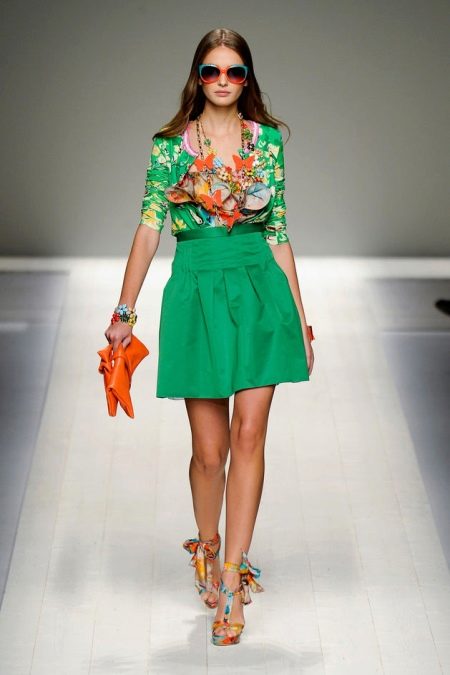
On an elastic band
A versatile model, indispensable for a hot summer. A gentle, romantic option for an informal setting. Light fabrics, such as chiffon, are perfect for sewing such skirts.



What to wear with
Sun and half sun skirts are wide enough, so it is best to combine them with a tight-fitting top: turtleneck, top, T-shirt, classic blouse, jumper, etc.
A very feminine option is a skirt with a cropped, fitted jacket. As accessories, you can use long bright beads, a chain, a voluminous scarf made of thin fabric.






Fluffy skirts go well with heeled shoes. It can be - classic shoes, wedge sandals, ankle boots or boots.

For sewing skirts, it is recommended to use soft materials that keep their shape well - linen, cotton, wool, etc. The color scheme knows no restrictions, but you need to be careful with prints. The fold itself is a decorative element. In a colorful, colorful skirt, the element can be "lost". Therefore, most often such models are sewn from plain fabrics, the cage is always relevant, a strip is permissible.

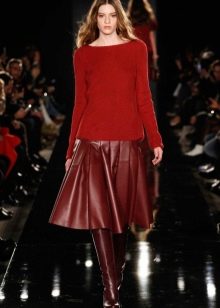

The sun skirt is sewn from a single piece of fabric or gussets. The pattern of the first option is very simple - a circle of the required diameter is drawn and a cut for the waist is made. This model has no seams, so it looks as lush and airy as possible. The half-sun skirt is not so voluminous, but it looks no less feminine and charming.

How to sew a half-sun skirt?
For sewing such a model, it is best to choose a fabric that keeps its shape well. In addition, the material must have the same properties in the direction of the lobe and transverse threads. This will prevent the skirt from pulling out while wearing.

For a pattern, you need to take the following measurements: OT (waist circumference), DP (front length), DB (side length) and back length (DZ).
For example, OT = 60 cm.
The radius of the skirt is calculated using the formula: R = 2 * OT / 6.28.
It is necessary to take into account the allowances for the fastener and folds, then the corrected formula will look like this:
R = 2 * (OT + X) / 6.28, where X is the size of the allowances. This value is different for each specific model.

Let's say the selected model has 2 folds in the front. On one fold, tissue is laid 2 times more than its depth. The depth of one fold is 3 cm, which means that the total width of one fold is 6 cm. Then the size of the allowance for both folds will be 6 * 2 = 12 cm.
Let's take into account the fastener allowance - 3 cm. Radius = 2 * (60 + 12 + 3) / 6.28 = 23.9 cm.
A drawing of a pattern is in progress:
- Horizontal and vertical lines are drawn. A compass is placed in the place of their intersection and an arc is drawn.
- Further, on the pattern, the lines of the middle of the front and rear panels are marked.
- Next, the location of the folds and fasteners are noted.
- At the waist, 3 cm are laid on the fastener, on both sides - 6 cm each. The future fold will be located here.
- From the resulting notch, measure the distance to the median line of the rear panel and halve it. The side seam will go through here.
- Now you can create the folds. From the middle line of the front fabric along the waist line, set aside 3 cm in both directions - the width of the future fold.

Sewing skirts-sun
To build a pattern for a pleated sun skirt, you first need to determine the radii:
- The inner radius will be 1/6 of the waist plus 10 cm.
- The outer radius is determined by the length of the future skirt.
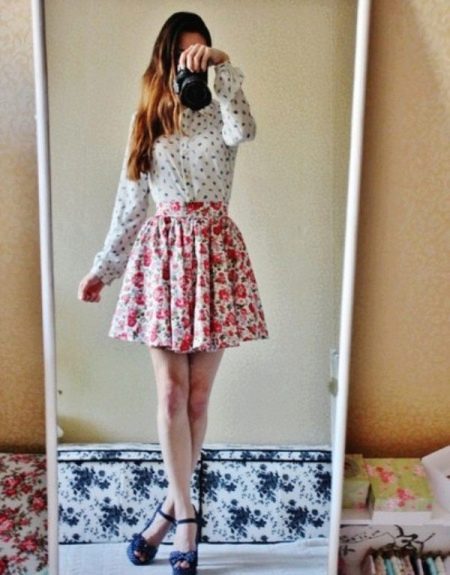
You do not have to make a pattern, but immediately outline the fabric. To do this, fold the selected fabric in four.Attach a measuring tape to its inner corner and use a chalk to draw circles along the fabric, then cut along the marked lines. Separately cut out the part for the future belt. Its width will be 12 cm, and its length should be your waist plus 5 cm.



Then proceed like this:
- Cut another piece of the belt from the non-woven fabric of any number to keep the future belt in shape.
- Iron the non-woven fabric to the belt.
- Fold the belt in half and iron, then for the wrong side, fold in one edge 1 cm and iron again.
- Cut a place for the zipper on the fabric you cut out.
- Stitch along the inside radius of the main part 5 mm from the edge. Put in a coarse step, and loosen the bobbin thread.
- While tightening one of the threads, create folds, evenly distributing them throughout the skirt. The inner radius should be pulled up to the waist circumference plus 2 cm.
- Sew on the front of the belt, then sew in the buckle, turn the skirt inside out and sew on the wrong side of the belt, closing the folds.






